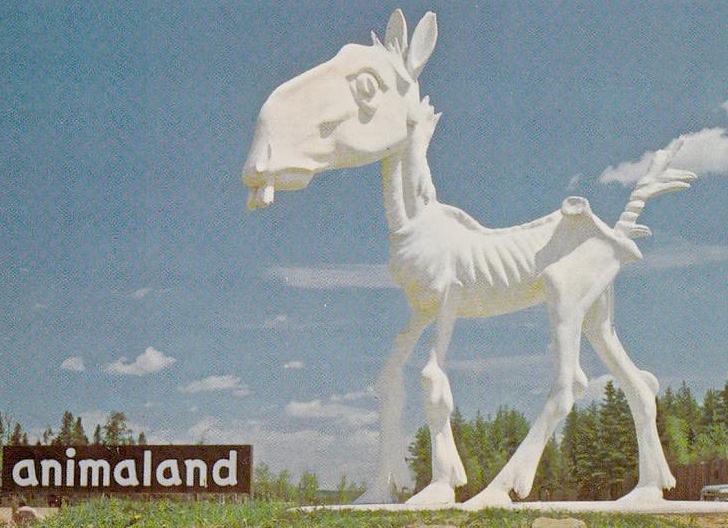Question: can we chip off pieces we like and leave the rest?
Purists and true believers will always say NO.
The question arises because I recently began to re-re-read Robertson Davies’ Deptford Trilogy (Fifth Business, The Manticore, World of Wonders), last visited maybe 20 years ago. Besides being a cracking good yarn and highly literate in a Canadian/British mode, it involves an extended meditation on entangled lives, on interwoven Stories, and on friendship. The second volume, The Manticore, was the source of pretty much everything I know of Jung. And now, in the context of thinking about life, and legacy, and Stories, it seems worthwhile to revisit one of the influential syntheses of the internal worlds.
Interlude: On our many passages between Nova Scotia and New England we would pass by a bizarre theme park/sculpture garden in deepest New Brunswick, called Animaland, the entrance to which was graced by a skeletal statue of a horse.

Betsy joked that it was “a place for the Jung at heart.”
Jungian analysis (AKA ‘analytic psychology’) proceeds from a foundation in anamnesis, an exercise by the analysand in extended autobiography (‘subjective confession’) aimed at confronting neurosis (seen as a “state of disunity with oneself”) and an attempt at self-cure of “mild dissociation of personality”.
“We can start almost anywhere. But from what you have told me I think we would be best to stick to the usual course and begin at the beginning.”
“Childhood recollections?”
“Yes, and reflections of your life up to now. Important things. Formative experiences. People who have meant much gto you, whether good or bad… We look at your history, and meet some people there whom you may know or perhaps you don’t, but who are portions of yourself…”
(The Manticore pg 70, 71)
This seems not irrelevant to some of what the Convivium is exploring. It’s not that I wish to immerse myself in Jungian bathos, but some of the terminology and background ideas may be provocative, evocative, useful to myself and others, so it’s useful to try to set out the framework, and to pick and choose elements that seem resonant.
…we are attempting to recapture some forgotten things and arousing almost forgotten feelings in the hope that we may throw new light on them, but even more new light on the present. Remember what I have said so many times; this is not simply rummaging in the trash-heap of the past for its own sake. It is your present situation and your future that concern us. All of what we are; talking about is gone and unchangeable; if it had no importance we could dismiss it. But it has importance, if we are to heal the present and ensure the future.
(The Manticore pg 100)
Powerful notions in the Jungian cosmology include the collective unconscious, broadly conceived as applicable to all Mankind, and coming from “somewhere beyond”, a “dynamic psychic substratum” encoded in myths “common to all humanity, on the basis of which each individual builds his or her private experience of life”—a grand and contentious notion [how transmitted? how across cultural/linguistic boundaries? from what origins? what are the Universals?].
Archetypes (“identical psychic structures common to all”) are another realm generally associated with Jung.
You may call these figures many things. You might call them the Comedy Company of the Psyche, but that would be flippant and not do justice to the cruel blows you have had from some of them. In my profession we call them archetypes, which means that they represent and body forth patterns to which human behavior seems to be disposed; patterns which repeat themselves endlessly, but never in precisely the same way…
(The Manticore, pg 229)
And here we quickly find ourselves in deep waters. I ran across a list of 300+ Archetypes, the most familiar of which are
The Self
The Anima
The Animus
The Shadow
The Persona
The Father
The Mother
The Child
The Wise Old (Sage)
The Hero
The Trickster
The Maiden
The poignancy of this Archetype thing may be appreciated with another list, immediately resonant for the males among us:
The four healthy archetypes of boyhood are:
The Divine Child
The Hero
The Precocious Child
The Oedipal ChildThe eight shadow archetypes of boyhood are:
The High Chair Tyrant
The Grandstander Bully
The Know-it-all Trickster
The Momma’s Boy
The Weakling Prince
The Coward
The Dummy
The Dreamer
Shudder.
In my search for efficient entrée into Jung, I’ve been reading the excellent Jung: A Very Short Introduction, and I also found Daryl Sharp’s Jung Lexicon: A Primer of Terms & Concepts, worth a few minutes of your time to scan and thus to realize how integral and hermetic and inward-facing the world of Jungians is, and how vast and dauntingly impenetrable. The idea of breaking off a few convenient ideas or insights would be Anathema to true believers, but there are tasty bits that seem to accord with notions we’ve already discussed among ourselves, such as
Individuation: to “realize one’s own potential, follow one’s own perception of the truth, and to become a whole person in one’s own right”, “to work with and confront the unconscious” as a lifelong process.
Projection: “confronted by a field of ignorance, we project into it our own psychic activity and fill it up with meaning.”
